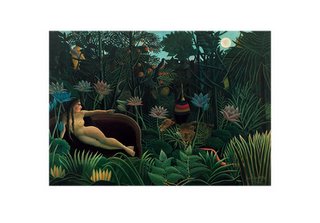Bacon and Rousseau

 Last Saturday I took myself down to Tate Britain to have a look at the mini exhibition of the works of Nathaniel Bacon, the gentleman artist, horticulturalist and latterly Knight of Bath. There are only nine surviving paintings believed to be by him and seven of them are in the show along with a couple of personal letters and other effects. The pictures fall into two catergories, the self-portraits and scenes of buxom young women surrounded by nature's bounty, be it vegetable and fruit or game and fowl. The self-portraits are intersting but do not captivate as much as the "Cookmaid" paintings. Perhaps it's because I like girls and food that these appeal so much but I must admit to being transfixed, as much as anything by the loving attention to detail with which everything is depicted; from cleavage to cabbage, from rosy cheek to pod of peas everything has had vast love and attention lavished upon it.
Last Saturday I took myself down to Tate Britain to have a look at the mini exhibition of the works of Nathaniel Bacon, the gentleman artist, horticulturalist and latterly Knight of Bath. There are only nine surviving paintings believed to be by him and seven of them are in the show along with a couple of personal letters and other effects. The pictures fall into two catergories, the self-portraits and scenes of buxom young women surrounded by nature's bounty, be it vegetable and fruit or game and fowl. The self-portraits are intersting but do not captivate as much as the "Cookmaid" paintings. Perhaps it's because I like girls and food that these appeal so much but I must admit to being transfixed, as much as anything by the loving attention to detail with which everything is depicted; from cleavage to cabbage, from rosy cheek to pod of peas everything has had vast love and attention lavished upon it.It was this attention to the surroundings as much as the figure which put me in mind of the Rousseau exhibition currently at Tate Modern. A very different era, but an equally passionate rendition of the foliage and fauna of the jungle. Both artists' work has a strange flatness about it because everything is equally precisely depicted. You would expect the least attention to be lavished upon the surroundings, so that the eye is drawn to the figure, but in both these artists' work every leaf is as important as a person, every item delights the artist enough to expend equal attention on it. Bacon was a keen hoticulturalist and his produce not only suggests bounty and wealth, but a deep pleasure in life and what humans may make of it. I might also suggest that the beautiful cookmaid connotes similar ideas. The food is a triumph of post-renaissance humanity over nature. Bacon succeeded in growing melons in Suffolk and they along with grapes are proudly displayed in the picture. This is a painting by a man who loves life and all it can offer and his enthusiasm extends even as far as carefully depicting the strand of excess stem still attached to the marrow.
Rousseau too seems to delight in the rich detail of the foliage, the raw unpredictability and massive complexity of nature. Though his jungles seem flat from a distance, up close they surround you, transport you and plug you directly into Conrad's "Heart of Darkness". It is easy to see the mixture of excitement, wonder and fear that the jungle would inspire in the France-bound Rousseau. The magic, the strangeness and sheer difference almost overwhelm both the artist and the viewer. Comparing these massive, epic canvasses with the twee little Parisian street scenes elsewhere in the show is like comapring night and day. One is full of promise and wonder, the other the reassuring sameness of everyday suburban living.
I love both of these shows dearly; their passion for their subjects cannot help but delight the eye, and summon up the spirit of all that makes this a fascinating world to inhabit and enjoy. If one word can be ascribed to both these exhibitions and their respective artists it is "passion". May we never lose it.
Labels: criticism


0 Comments:
Post a Comment
<< Home